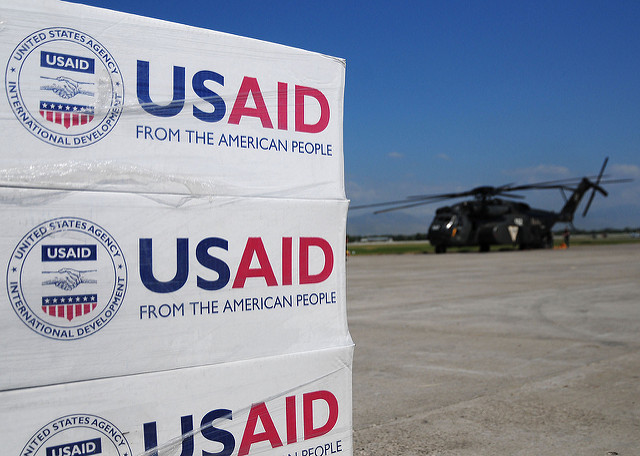by Diana Ohlbaum
It comes as little surprise that the Trump Administration is preparing plans to eliminate the U.S. Agency for International Development (USAID), whose mission is to “end extreme poverty and promote resilient, democratic societies.” Trump’s xenophobic, “America First” rhetoric leaves little room for enlightened engagement with the world, and his budget targets development for disabling cuts. The Heritage Foundation, whose staff members and policy prescriptions have been influential in the new administration, has consistently advocated phasing out USAID. The House Freedom Caucus proposed, as part of its first 100-day agenda, renaming the State Department’s Bureau of Economic and Business Affairs to reflect incorporation of USAID’s responsibilities.
Attempts to do away with USAID are not new, nor are they limited to Republican administrations. In 1992, under a mandate from the Democratic-controlled Congress, President George H.W. Bush established an advisory commission on foreign aid management that recommended abolishing USAID and transferring its functions to the State Department. In 1995, Secretary of State Warren Christopher asked for a take-over of USAID and two other agencies. After several years of wrangling within the executive branch, and between the Clinton administration and a Republican-led Congress, USAID won its formal independence but lost control over certain press and administrative functions. In January 2001, the Hart-Rudman Commission, chartered by Secretary of Defense William Cohen, called for the reorganization of the Department of State, including absorption of USAID. Five years later Secretary of State Condoleezza Rice created a foreign assistance office inside the State Department, which usurped USAID’s budget and policy authorities. As recently as 2009, a roadmap for the “integration” of USAID into the Department of State was presented to the Obama administration.
Considering this history of bipartisan enthusiasm for consolidating agencies, the battle to save USAID will be an uphill one. Other countries—most recently Canada and Australia—have amalgamated their aid agencies with their foreign ministries. Even though former USAID Administrator Raj Shah was extremely popular with Republicans, and congressional support for USAID today is stronger than at any time since the end of the Cold War, members are more enthusiastic about the development mission than the development agency.
So, if both sides have proposed it, and everyone else is doing it, what’s the problem? To put it simply: consolidation of USAID into the State Department is, and always has been, a power play, not a cost-cutting measure. It’s not about making aid more efficient or effective. It’s about making aid more political.
Development and diplomacy require different types of knowledge, training, and experience, and they produce different organizational cultures. The State Department values representation and reporting skills; USAID values expertise in program planning and contract management. Success for a diplomat is getting a foreign government to support U.S. policy aims; success for a development professional is getting a foreign government to meet the needs and demands of its own population. The State Department focuses on short-term political gains that often can be measured in weeks or months; USAID seeks economic and social transformation that can take decades. Where USAID has been least effective—Iraq, Afghanistan, Pakistan, Haiti—it has been in part because USAID’s budgets, policies, and programs have been dictated by the State and Defense Departments rather than by the norms of good development practice.
The bottom line is that development is a discipline. Merging USAID into the State Department makes about as much sense as merging the Central Intelligence Agency into the Department of Defense. They must—and do—cooperate and collaborate, but they have separate missions and separate structures for good reason.
Advocates of a USAID merger make two basic arguments: that USAID is poorly managed and can’t be trusted to carry out U.S. foreign policy objectives, and that significant savings can be achieved by bureaucratic consolidation. Both are based on outdated information and faulty logic.
First, these arguments ignore the significant overhaul of USAID over the last decade. Its structure, policies, and processes have been modernized to improve transparency, oversight, and accountability. It has rebuilt its capacity to use data and evidence to inform decision-making and achieve greater impact. Former administrator Raj Shah established a Development Lab to bring science, technology, innovation, and partnership to the fore of development efforts. USAID’s principal constraints are now the arcane web of laws, directives, and policy requirements imposed by Congress, which apply to the streams of money no matter which department is charged with spending it. Tellingly, the Heritage Foundation’s recommendations for reforming the State Department and merging USAID are based on a 16-year old report.
Second, merger proponents fail to acknowledge how much control the State Department already has over USAID. By law, USAID’s administrator operates “under the direct authority and foreign policy guidance of the Secretary of State.” The State Department supervises and approves USAID’s budget. U.S. ambassadors hold sway over whether USAID opens or closes overseas missions and how many staff it can maintain in a country. All too often, it is the State Department that seeks to initiate or continue aid programs in kleptocratic states, seeking to buy favors from friendly autocrats—and leaving USAID to suffer the reputational consequences. If Congress truly believes in the importance of development, it should give USAID more autonomy, not less.
Finally, most of the efficiency savings from administrative consolidation have already been achieved—at a high cost to aid effectiveness. Moving USAID missions into embassy compounds may have reduced operating expenses, but it has hindered outreach to local populations. Shared motor pools mean that USAID officers, shunted to the bottom of the priority list, have fewer opportunities to visit the projects they are responsible for overseeing. Joint information technology systems complicate USAID’s procurement and financial management tasks. Common pay scales for foreign nationals hired by USAID and the State Department mean that USAID must offer its local Ph.Ds and technical experts the same salaries as the drivers and gardeners hired by the embassy. When the State Department took over USAID’s budget and policy planning operations in 2006, the agency was effectively lobotomized, leaving programs without an evidence base for decision-making.
Dismantling USAID is the bad penny that keeps on turning up to distract attention from the real challenges to U.S. foreign aid and diplomacy. Those who want to see measurable progress in reducing global poverty and hunger and preventing conflict and crisis ought to stand up for the agency best placed to achieve it.
This is the second of four articles on how U.S. soft power ends. The first, on diplomacy and development aid, can be found here. The third, on disparaging diplomacy, can be found here. The fourth, on foreign aid reform, can be found here. Photo from USAID via Flickr.






Interesting article and some of the previous comments are well taken. One touches on USAID’s heavy burden of rules and regulations. Some are imposed on the agency by Congress but some are internal, designed to ensure that programs are based on sound development theory and evidence. But all too often the Department of State does call the shots and tells USAID what to implement. Assuming they have their own, good reasons, I’m led to my first conclusion: there needs to be a clear separation between politically-motivated “aid” projects and projects that are truly meant to produce a development outcome such as reducing poverty, disease, malnutrition, illiteracy, etc.
At the same time, USAID does need some examining to see what types of projects really do produce results as one of your commenters noted. The agency’s track record isn’t likely to improve much in my opinion because ultimately what hinders development in most countries is the resistance of that country’s elites to change that reduces their ability to profit from political connections–even though the changes would benefit the rest of the population. This brings me to my second conclusion, which is that all development assistance (except disaster and humanitarian aid) should be linked to a host country’s government’s real progress in reforming itself to benefit the general population, even if the changes take away elites’ avenues for self-enrichment. The Millennium Challenge Corporation (MCC) already has criteria set up for measuring this and those criteria could be adopted.
So maybe USAID should go away, State should get the capability to manage its politically motivated projects, and the MCC should absorb the truly development-focused project management expertise. That could give the administration a “win” yet keep development out of the political realm. (Full disclosure: I’m a USAID foreign service officer but the opinions I express here are my own personal opinions and don’t reflect the opinion of USAID or the United States Government.)